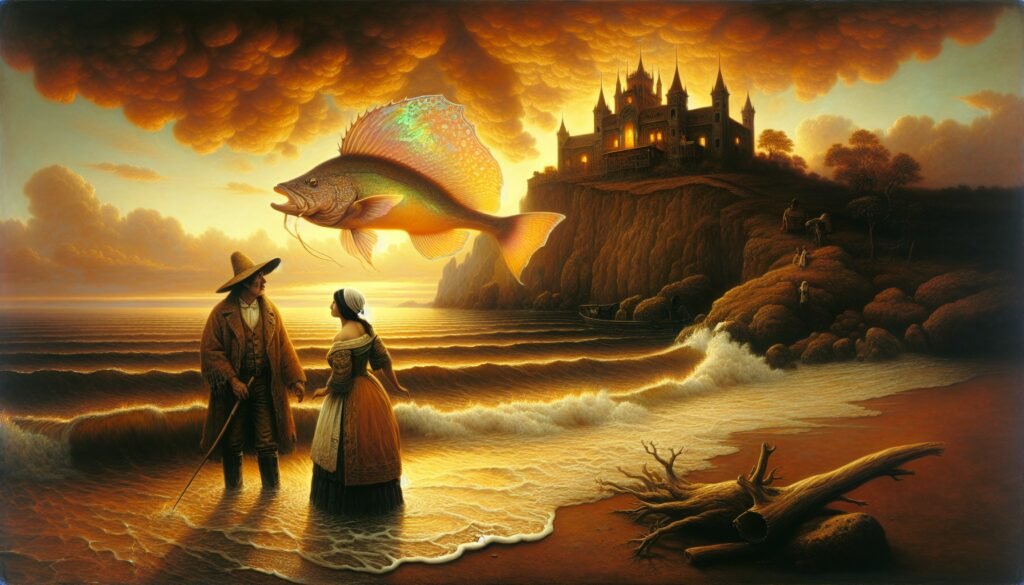Once upon a time, nestled in the heart of storytelling history, there lived a tale as old as imagination itself, “The Fisherman and His Wife.” This enchanting story, collected by the legendary Brothers Grimm, has been whispered from one generation to the next, teaching the timeless lessons of desire, contentment, and the consequences of greed. Tonight, let us dive into this classic fairy tale, unraveling its rich tapestry for our little ones to find comfort and wisdom before they drift off to sleep.
Our story begins with a humble fisherman and his wife who live in a small, dilapidated hut by the sea. One day, the fisherman catches a flounder that claims to be an enchanted prince. The story unfolds from there, spinning a web of wishes and the very human struggle between satisfaction and the thirst for more. So, tuck in, and let’s explore the depths of this moral story that has captivated children and adults alike through the ages.
What is the origin of The Fisherman and His Wife?
The tale of The Fisherman and His Wife finds its origin in the rich soil of folklore, meticulously collected by Jacob and Wilhelm Grimm, the scholars known as the Brothers Grimm. As folklorists, they sought to preserve the cultural narratives of the German people, often finding that the same stories echoed in different tongues and traditions across Europe.
The Fisherman and His Wife, like many fairy tales, likely evolved from an amalgam of oral traditions before being penned down in the early 19th century. The story’s longevity and appeal can be attributed to its relatable characters and the universal truths it imparts. It is a tale that transcends its origins, finding a home in every culture that cherishes the power of story.
While the Brothers Grimm are credited with the tale’s popularization, its roots stretch back further, weaving through the cultural fabric of many societies. It has been adapted and retold countless times, each version reflecting the values and lessons important to the people who tell it.
Who are the Brothers Grimm and their role in the story?
The Brothers Grimm, Jacob and Wilhelm, were German academics, philologists, cultural researchers, and authors who together specialized in collecting and publishing folklore during the 19th century. Their work was pivotal in the preservation of Germanic folk tales that might otherwise have been lost to time.
In their role as storytellers, they functioned as both archaeologists and architects—digging deep into the past to unearth ancient stories like “The Fisherman and His Wife,” and then building them anew for contemporary audiences. Their dedication to their craft ensured that tales brimming with moral lessons continued to educate and entertain long after their original tellers had passed.
Their version of “The Fisherman and His Wife” stands as a testament to their mission, capturing the essence of the tale’s moral while dressing it in the simplicity and wonder that characterize so many Brothers Grimm classic tales.
What are the main themes of The Fisherman and His Wife?
The story of “The Fisherman and His Wife” is heavy with themes that resonate through time. Central among them is the danger of greed and the eternal question of what it truly means to be content. As the fisherman’s wife goes from wish to grandiose wish, the theme of insatiability becomes clear, cautioning readers against the perils of never being satisfied.
Another pivotal theme is the balance between humanity and nature. The enchanted flounder represents the natural world, which, when exploited beyond its means, can lead to ruin. This theme is particularly relevant in our modern times, reminding us to respect and live in harmony with nature.
The power dynamics in relationships also play a crucial role, depicting the influence of one spouse upon the other and raising questions about autonomy, persuasion, and the consequences of yielding to another’s will.
How do variants reflect cultural differences?
As with many fairy tales, “The Fisherman and His Wife” has been retold across cultures, each adding its unique flavor. Adaptations of The Fisherman and His Wife reflect differing societal norms, values, and the specific lessons those cultures wish to impart to their children.
In some variants, the magical being is not a fish but other creatures significant to the local folklore. The wishes granted may vary too, reflecting what each culture considers as symbols of wealth or success. The essence of the story remains, but its colors change with the landscape, painting a vivid picture of a world rich in diversity yet bound by common threads.
What moral lessons can be learned from the tale?
The tale of “The Fisherman and His Wife” is laden with moral stories for children, the foremost being a warning against greed. It teaches that always wanting more can lead to losing everything, emphasizing the virtue of gratitude for what one has.
Another lesson is the importance of making wise choices and considering the consequences of our actions. The fisherman’s wife’s relentless pursuit of a grander life ultimately leads to her downfall, underscoring the idea that unchecked ambition can be destructive.
The story also encourages discussing one’s desires and decisions with loved ones, as the fisherman often does with his wife, though her refusal to listen highlights the importance of mutual respect and understanding within relationships.
How has The Fisherman and His Wife influenced modern media?
From picture books to animated films, “The Fisherman and His Wife” has left its watermark on modern media. The narrative’s adaptability has allowed it to surface in various forms, from direct retellings to being an underlying current in new creations.
Children’s literature often sees the tale simplified and illustrated, bringing its complex themes within the grasp of young minds. Meanwhile, film and television have woven elements of the story into modern-day plots, emphasizing its timeless relevance.
Even in music and theatre, echoes of the tale can be found, with composers and playwrights drawing inspiration from its narrative to craft works that speak to audiences across the spectrum of society.
In conclusion, the tale of “The Fisherman and His Wife” stands as a beacon of storytelling, its light guiding us through the murky waters of desire and contentment. As we pass on this story to our children, we hand down not just a narrative, but a compass to help them navigate the vast ocean of life’s many challenges and blessings.


Leave a Reply